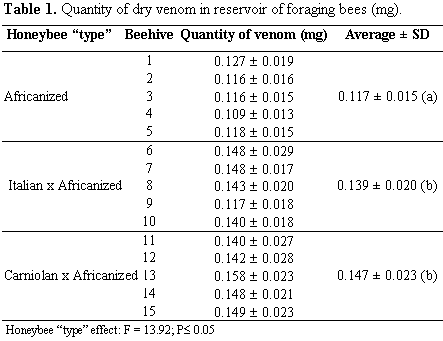This study used 15 beehives: five with Africanized queens sisters (Apis mellifera), five with Italian queens sisters (Apis mellifera ligustica), and five with Carniolan queens sisters (Apis mellifera carnica). The queens were fertilized naturally. This experiment was performed in the apiary of the Botucatu School of Veterinary Medicine and Animal Husbandry, UNESP, State of São Paulo, Brazil. The following data were obtained from the foraging bees: venom quantity in reservoir, 0.117±0.015, 0.139±0.020, and 0.147±0.024 (mg); venom quantity liberated in extraction apparatus, 0.073±0.012, 0.057±0.011 and 0.059±0.013 (mg); and sting electro stimulus threshold (volts), 10.75±1.37, 15.11±2.00, and 15.01±1.63 for Africanized, Italian x Africanized and Carniolan x Africanized, respectively. The Africanized honeybees possess less venom in reservoir than the European hybrids (Carniolan and Italian). However, they liberated a larger quantity of venom in the extraction apparatus and required lower electro stimulus threshold to promote stinging.
Venom reservoir; Apis mellifera scutellata; defensive behavior; venom extraction apparatus; Africanized honeybees; Carniolan honeybees; Italian honeybees




